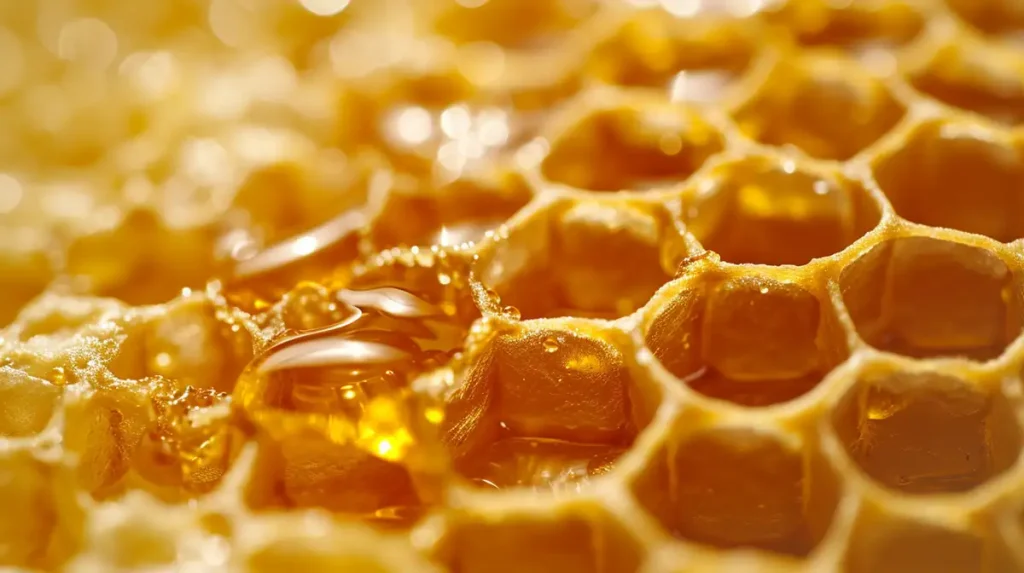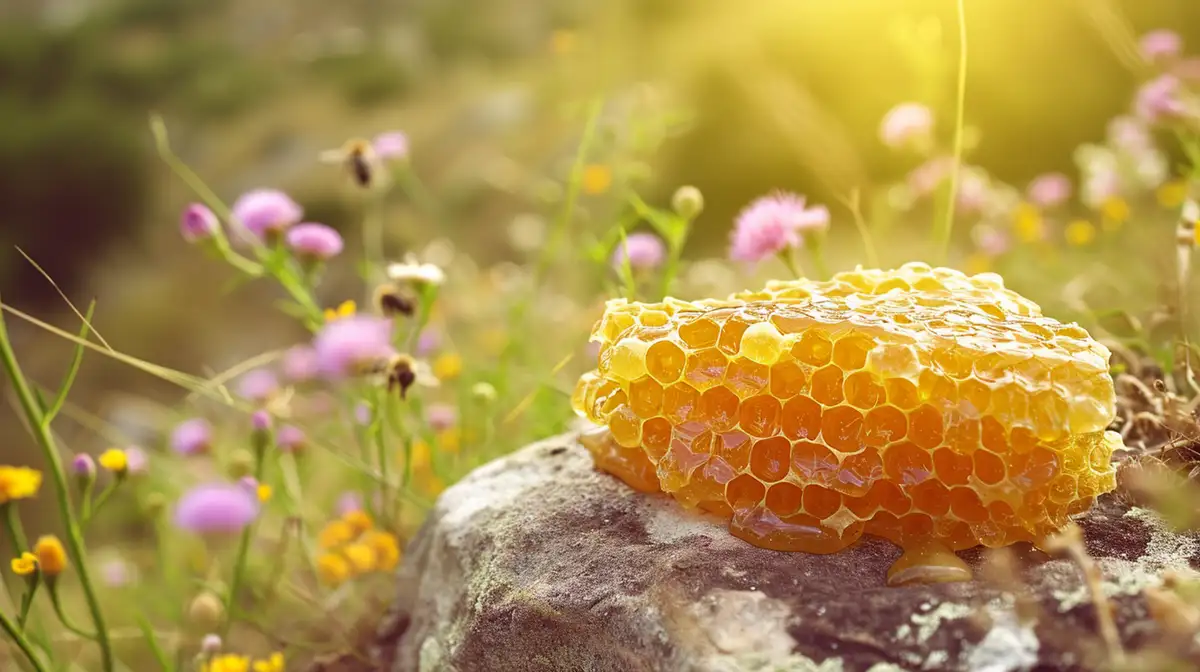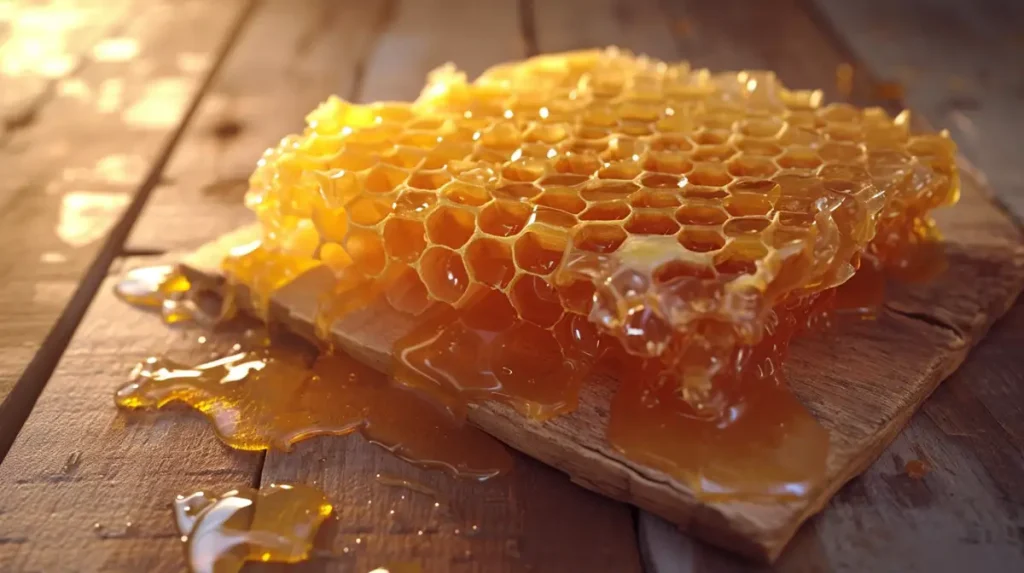Table of Contents
Can you eat honeycomb? Absolutely, honeycomb is not only edible but also a delicacy in many cultures. It consists of beeswax cells filled with honey, which you can chew to release the honey. The wax itself is also edible, though some people prefer to spit it out after extracting the honey. Rich in carbohydrates and antioxidants, honeycomb is a natural treat that offers a unique textural experience, combining the smoothness of honey with the subtle, chewy texture of the wax.
In the below paragraphs, we will take a more detailed look at this topic.
Most people know what honeycomb looks like, and they know the fact that it can be found within beehives. Honeycomb is made by bees, and it is within these structures that they store both pollen and honey. Honeycomb is also used as a home for larvae, and it may contain small amounts of propolis, royal jelly, and bee pollen. Nevertheless, is honeycomb edible?
Yes. Like honey, honeycomb is edible and is perfectly safe to eat. You can eat the waxy cells as well as the honey within it.
Should You Eat Honeycomb?
I can tell you that honeycomb is a unique and delightful addition to any foodie’s repertoire. Honeycomb is made up of hexagonal cells that bees build with wax and is filled with delicious, nutrient-rich honey that bees collect from flowers.
Eating honeycomb is safe and healthy, as long as it is harvested and processed properly. However, it’s important to note that while honeycomb is edible, it may not be suitable for everyone. For example, individuals with bee allergies should not consume honeycomb as it could cause an allergic reaction.
One of the biggest benefits of eating honeycomb is its nutritional value. Honeycomb contains a wide range of nutrients, including vitamins, minerals, enzymes, and antioxidants, making it a healthy addition to any diet. In addition, honeycomb has anti-inflammatory and antibacterial properties, making it a great natural remedy for sore throats, colds, and coughs.

When it comes to the taste of honeycomb, it can vary depending on several factors including the type of flowers the bees have access to, the time of year and the region where the bees live. As a result, honeycomb can have a unique flavor profile that ranges from light and floral to dark and robust. The texture of honeycomb can also vary depending on the age of the comb, with fresh honeycomb being soft and chewy while older honeycomb is more crunchy and brittle.
If you’re new to eating honeycomb, it’s important to note that it is not only delicious but also versatile. Honeycomb can be enjoyed on its own as a sweet treat, or it can be paired with other foods to create a variety of tasty dishes. For example, honeycomb can be used to add sweetness and texture to cheese plates, salads, and charcuterie boards. It can also be used as a topping for ice cream, yogurt, and oatmeal, or added to baked goods like muffins and cakes for an extra burst of flavor.
The Benefits of Eating Honeycomb
As well as its delicious taste, honeycomb is also rich in a number of nutrients, making it an extremely beneficially healthy snack. The raw honey within the honeycomb contains glucose oxidase, giving it antibacterial and antimicrobial properties. These properties are rarely found in commercial honey because of the way it is produced.
Another benefit of eating honeycomb is that you get the great taste of honey without any of the added sweeteners that is typically found in commercially processed honey.
The antioxidants found in raw honey help to reduce inflammation and promote good health, with research suggesting that polyphenols reduce the risk of illnesses such as heart disease, dementia, diabetes, and even some forms of cancer. The beeswax found in honeycomb can help to lower cholesterol in some people.
- Carter, Anthony (Author)
- English (Publication Language)
- 194 Pages - 02/28/2024 (Publication Date) - Independently published (Publisher)

Can You Eat Honeycomb Straight from the Hive?
When it comes to eating honeycomb, the part that contains capped honey is the best to consume. Capped honey refers to the honey that has been sealed with a layer of wax by the bees to protect it. This honey is usually mature and of higher quality compared to the uncapped one, which may still be in the process of drying or fermenting.
To eat honeycomb you can simply bite or chew on the wax cells, which will release the honey into your mouth. The wax is entirely safe to eat and is a good source of dietary fiber, which aids in digestion. Some people prefer to chew the wax like gum and swallow it while others choose to spit it out. The choice is entirely up to you.. Honeycomb is also a great addition to cheese platters and fruit bowls, providing a touch of sweetness and texture.
It is worth noting that consuming honeycomb from a hive requires careful consideration of safety precautions. Bees can be aggressive when they feel threatened, so it is essential to wear protective clothing including a beekeeping suit, gloves, and a veil. Furthermore, it is crucial to ensure that the honeycomb is free from any contaminants.
How to Eat Honeycomb
Now that you know honeycomb is edible, you might be wondering what the best way is to eat it. As mentioned above, the simplest way to eat it is to just cut off a piece and chew it, either swallowing the waxy cells or spitting them out once you have had all the delicious honey. However, there are other ways to enjoy this mouth-watering treat as well.
Honeycomb can be effortlessly paired with other foods for a snack or as an after-dinner alternative to a dessert. For example, if you love a cheese board, why not add some honeycomb? Honeycomb is delicious with many cheeses, particularly salty varieties such as Manchego and Parmigiano Reggiano. To really wow guests at a dinner party, you could also add some nuts like walnuts and pecans, which pair really well with honeycomb and cheese.
Honeycomb can also be added to salads to make them more interesting. Some people love to add chunks of honeycomb with a delicious goat’s cheese such as feta to their salad to make it a more inviting meal.
Breakfast can also become more interesting when you add chunks of honeycomb. Think about spreading it over hot waffles or pancakes or even adding it to a steaming bowl of oatmeal. If you love Greek yoghurt, a chunk of honeycomb with some mixed berries will really hit the spot.
How Much Honeycomb is Safe to Eat?
Honeycomb is safe to eat but it should be eaten in moderation due to the fact that it can contain botulinum spores. Eating large quantities of honeycomb can therefore cause stomach problems in some people.
Warning: It is also important to be aware that honeycomb and honey is not really advised for pregnant women and it should never be given to children under the age of twelve months (because of the botulinum spores).
Another point to mention here is that honeycomb is high in sugar, so it should not be eaten in large amounts, regardless of how delicious it is!
What Does Honeycomb Taste Like?
Honeycomb itself is waxy and chewy but because it contains honey, the taste is quite sweet. If you have never had raw honey, you might be surprised at how different it tastes to commercial honey. Commercial honey is processed and is boiled before sweeteners are added. Raw honey is taken straight from the hive and is sweet and delicious. As mentioned above, the taste of raw honey will vary depending on the flowers predominantly found in the area around the hive.
Honey near to the inside of honeycomb often crystalizes, which can make it sweeter and more crunchy than regular honey.
How Long Does Honeycomb Last?
Just like honey, honeycomb could last forever if stored properly. It is important not to allow moisture or any other foreign substances to get into the container. This means, you should only use clean utensils to remove the honey and honeycomb from the container in which it is kept.
Honeycomb should be kept in a sealed container and stored at room temperature. Remember, honey will often crystalize, but you can simply warm it up to soften it again if you want to spread it.
If you have a lot of honey that you don’t think you will use for some time, you can freeze it. However, unless you have run out of storage space, this is not necessary.
Can You Eat Honeycomb – Conclusion
Honeycomb is a product made by bees to store their honey as well as other by-products of their gathering lives. Honeycomb is a waxy substance that can be eaten along with the honey but should be done in moderation. Like honey, honeycomb does not expire when stored properly and can be eaten with other foods such as cheese, nuts, and chocolate for a delicious snack. Nevertheless, because of the fact that honey can contain botulinum spores, it should never be consumed by pregnant women and children under the age of twelve months.
Looking to up your beekeeping game? Check out our latest product recommendations so you can take things to the next level!
Introducing The Top 12 Best Beekeeping Veils For 2024
Introducing The Top 20 Best Beekeeping Gloves For 2024
Introducing The Absolute Best Beekeeping Suits For 2024
The 15 Top Beekeeping Books for 2024
The Top 11 Honey Extractors for 2024
The Top 12 Mason Bee Houses for 2024
Beekeeping Disclaimer:
Beekeeping, like any agricultural activity, involves inherent risks. It is important to understand these risks and take appropriate measures to mitigate them.
Potential risks associated with beekeeping include:
- Bee stings: Honey bees are generally not aggressive but can become defensive if they feel threatened or their hive is disturbed. Bee stings can cause allergic reactions or even anaphylaxis in some individuals, which can be life-threatening. It is important to wear protective clothing and follow best practices when handling bees to minimize the risk of stings.
- Diseases and pests: Bees can be vulnerable to various diseases and pests, including mites, viruses, and bacterial infections. These can have significant impacts on bee colonies, leading to reduced honey production or even colony collapse. It is important to monitor hives regularly and take appropriate measures to prevent and treat diseases and pests.
- Weather conditions: Extreme weather conditions, such as drought or cold temperatures, can affect the health and productivity of bee colonies. It is important to ensure that hives are appropriately sheltered and provided with adequate food and water.
- Environmental hazards: Bees can be affected by environmental hazards such as pesticide exposure, pollution, and habitat loss. It is important to be aware of these hazards and take appropriate measures to protect bee colonies and promote healthy environments for bees.
- Legal requirements: Beekeeping may be subject to local, state, or national regulations, such as registration or inspection requirements. It is important to be aware of these requirements and comply with them.
While beekeeping can be a rewarding and enjoyable activity, it is important to be aware of the potential risks and take appropriate measures to mitigate them. By following best practices and staying informed about the latest developments in beekeeping, beekeepers can help ensure the health and productivity of their hives and contribute to the well-being of bee populations worldwide.
Photo Credits:
- Featured Image (Honeycomb of Western Honeybee with Eggs and Larvae): Waugsberg – CC BY-SA 2.5
- Honeycomb: Merdal – CC BY-SA 3.0
Last update on 2024-04-25 / Affiliate links / Images from Amazon Product Advertising API


